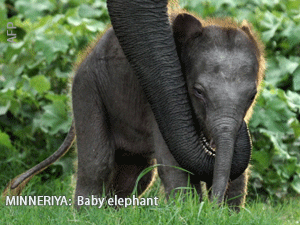100 per cent carbon neutral, 100 per cent green, 100 per cent ethical factory !


I am standing in a palm-filled courtyard filled with bird song in Thurulie, two hours’ drive from Colombo, the capital of Sri Lanka and, to be honest, what I'm seeing has restored my faith in fashion as a force for good.
I am in the world’s first 100 per cent carbon neutral, 100 per cent green, 100 per cent ethical factory.
Funded and built by Marks & Spencer in partnership with a local, award-winning manufacturer called, confusingly, MAS, this temple to sustainability is about to produce the world’s first eco underwear: the Per Una organic cotton bra, at £14, with matching knickers at £6, available in shops in January.
There are 'cool roofs', which reflect the sun. There are huge windows that magically let in natural light, but keep heat out. There is rainwater harvesting, which has reduced water consumption by 50 per cent, and Sri Lanka's biggest array of solar panels, reducing electricity consumption by 40 per cent. And staggeringly, every single one of the workers has a view of palm trees and the natural lake with its lily pads, flocks of pelicans and the mountains beyond.
I am taken on a tour of the effluent treatment works – my, fashion can be so glamorous – that convert waste into drinking water, and am shocked to learn that of all the garment manufacturers in the world, only M&S insists each of its factories treats its waste.
Instead of air conditioning there is an ingenious system called 'evaporative cooling', which uses 75 per cent less energy.
'The building had to work,' says Vidhura Ralapanawe, the super-enthusiastic manager of sustainability. 'We couldn’t have perspiration on the clothes.'
The factory, that will soon be making a high percentage of all M&S undies, was opened in April this year by Sir Stuart Rose, executive chairman of Marks & Spencer.
They are very into 'empowerment' here. Women, who make up 90 per cent of the 915 workforce, are encouraged to maintain a good work life balance, and to climb their way up the career ladder: a third of management are female. The factory has deliberately been built in a rural area, so that employees can remain in their villages.
Wages are 35 per cent more than the minimum: the monthly package (including social security contributions, free breakfast, a free health clinic and counseling, a transport allowance) starts at 10,480 Sir Lankan Rupees, which is about £58 (teachers here earn about £36 per month).
Walking round the factory floor, instead of the endless monotonous production 'lines' there are 'cells', each with 24 members, who take it in turns to be cutters, machinists, packers, thus avoiding boredom.
Pregnant women, who wear white scarves for easy identification, are given lighter work loads, special food and 84 days’ paid maternity leave. There are three employees with disabilities (M&S started an initiative to employ disabled people in Asia in 2004). There is no one here under the age of 16.
What I found incredible was that whereas in West we might moan about having to recycle, about not flying abroad on holiday, the people I meet in Sri Lanka, at the sharp end of climate change, are committed to helping solve a problem they didn’t even create. Factory worker Sudhammika Herath, 27, says she finds working in the eco factory 'less hot, much more cheerful. And I take what I learn here home: I recycle, I never waste water'.
When I tell Krishan Hundal, head of technology for clothing, home and beauty and who is giving me a guided tour, that it all seems too good to be true, and ask how on Earth such practices can be economical, he explains that 'Plan A, 22 months in, is cost neutral: we put money in the budget to pay for it but we just haven’t used it.
'There is less waste, because quality is second to none; we retain our highly skilled staff, and there is less absenteeism, because people feel part of something, that the business belongs to them, that we care'.
As Krishan Hundal points out, 'Basically, we can sleep at night. And our shoppers can sleep at night, too.'
Source: Liz Jones, Mail Online


.jpg)
.jpg)
.jpg)













